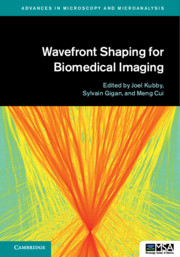Book contents
- Frontmatter
- Dedication
- Contents
- Contributors
- Preface
- Notation
- Part I Adaptive Optical Microscopy for Biological Imaging
- Part II Deep Tissue Microscopy
- Part III Focusing Light through Turbid Media Using the Scattering Matrix
- 5 Transmission Matrix Approach to Light Control in Complex Media
- 6 Coupling Optical Wavefront Shaping and Photoacoustics
- 7 Imaging and Controlling Light Propagation Deep within Scattering Media Using a Time-Resolved Reflection Matrix
- Part IV Focusing Light through Turbid Media Using Feedback Optimization
- Part V Time Reversal, Optical Phase Conjugation
- Part VI Shaped Beams for Light Sheet Microscopy
- Part VII Tomography
- Index
- Plate Section
6 - Coupling Optical Wavefront Shaping and Photoacoustics
from Part III - Focusing Light through Turbid Media Using the Scattering Matrix
Published online by Cambridge University Press: 10 June 2019
- Frontmatter
- Dedication
- Contents
- Contributors
- Preface
- Notation
- Part I Adaptive Optical Microscopy for Biological Imaging
- Part II Deep Tissue Microscopy
- Part III Focusing Light through Turbid Media Using the Scattering Matrix
- 5 Transmission Matrix Approach to Light Control in Complex Media
- 6 Coupling Optical Wavefront Shaping and Photoacoustics
- 7 Imaging and Controlling Light Propagation Deep within Scattering Media Using a Time-Resolved Reflection Matrix
- Part IV Focusing Light through Turbid Media Using Feedback Optimization
- Part V Time Reversal, Optical Phase Conjugation
- Part VI Shaped Beams for Light Sheet Microscopy
- Part VII Tomography
- Index
- Plate Section
Summary
- Type
- Chapter
- Information
- Wavefront Shaping for Biomedical Imaging , pp. 138 - 160Publisher: Cambridge University PressPrint publication year: 2019



